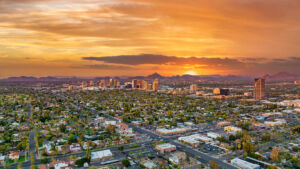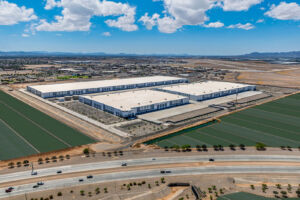Demolition of what once was a Motorola facility at 52nd Street and McDowell Road has commenced, making way for revitalization of this storied site in Phoenix. Located minutes away from Sky Harbor Airport, Arizona State University, Scottsdale and Downtown Phoenix, Dan Slack, president and COO of Baker Development, says that the concept for the property is to reinvigorate a site that has been passed over despite being a prime location in the Valley with ample power and water resources.
MORE NEWS: Ranking Arizona: Top 10 general contractors for 2024
“By starting the demolition of the project, we’re trying to open the eyes of not only local and national companies, but international companies so they see there’s an opportunity to have 62 acres in the center of Phoenix. It has so many attributes that other sites don’t, but given its current state, people don’t think of it as an opportunity for development,” he says.
With a potential to accommodate anywhere from 1.5 to 2 million square feet of uses ranging from a combination of office space, advanced manufacturing, R&D, distribution, logistics and more, Slack says this site is ideal for a corporate campus since it will be a blank slate for a business to enact its vision.
“The site will have a dedicated substation, and we’re already working with the utility provider to bring, which does differentiate it from many other sites in the area,” he continues. “The property already was served by a high level of power because of what it was historically, and we’re just enhancing that.”
John Werstler, senior vice president at CBRE, agrees that the substation is an asset for the property, adding that energy is becoming harder to come by in the region.
“It’s a big issue for everybody with all the new data centers and manufacturers coming in,” he says. “We’re quickly running out of power, and both SRP and APS need to increase capacity.”
The location is a rarity considering it is an infill property close to the middle of Phoenix. Slack notes that there are far more sites that are 60 or more acres in surrounding markets, comparing this lot to “oceanfront property in Malibu.” Another unique aspect of the site is that it is a single piece of land.
“Typically, to assemble 62 acres of contiguous property, you’d have to buy up multiple lots and you end up herding a bunch of cats,” Slack explains. “There are issues with simultaneous closings, and if someone doesn’t want to close, that holds the whole thing up. With this location, you don’t have that additional complexity — it’s a single piece. It’s unique to have 62 acres of infill and to be able to redevelop it all together.”
A Historical Site
Before TSMC and Intel earned the Valley the moniker of the “Silicon Desert” thanks to tens of billions in investment, Motorola opened its first facility in Arizona in 1949 and kickstarted the Valley’s advanced manufacturing capacity. Seven years later, Motorola opened another facility at 52nd Street and McDowell Road.
Since there was no municipal sewer available, on-site disposal of domestic and industrial waste in underground tanks, leaching fields, drywells and surface disposal areas was required, according to the Arizona Department of Environmental Quality. During the following decades, it was discovered that some of the chemicals stored there, mainly the solvents TCE and TCA had leaked, contaminating the area.
“Motorola was cleaning things like uniforms with TCE and dumped it in the ground. A lot of companies did the same thing in the ‘60s and the ‘70s,” Werstler explains. “They did that for years, which caused the groundwater pollution.”
Due to the environmental hazard, the site was deemed a superfund site, which is a designation from the Environmental Protection Agency that allows it to clean up a contaminated site and forces the responsible group to either perform the work needed or reimburse the government for doing so.
The market was skeptical of the property because people didn’t want to take on whatever risks they thought were associated with a superfund site, but Werstler says that fear has already been addressed.
“Motorola has been remediating the site over the years, and it came up with a clever idea,” he continues. “I’ve sold properties that are superfunds or have environmental issues, and Motorola was one of the few that decided that the best way to handle the situation was to retain ownership
and responsibility of everything below grade where the pollution is. The new buyer just purchases the top 18 inches so there’s really no risk, and that has worked out well.”
That said, Baker Development has worked for three years to implement a remediation strategy and obtain the necessary approvals to redevelop the site.
“Our team has a unique expertise in understanding, devising and executing complex redevelopment strategies to transform superfund and brownfield sites to zero-risk properties,” Warren Baker, CEO of Baker Development, says in a press release.
Slack concludes that Greater Phoenix is a top tier market thanks to its population growth, its pro-business climate and organizations such as GPEC and the Arizona Commerce Authority creating a welcoming atmosphere, so companies want to locate in the Valley.
“I would put this project up against anything in the U.S.,” he says. “This is probably the best opportunity for a business to locate their corporate playground here in the middle of Phoenix, with access to everything they may want.”




